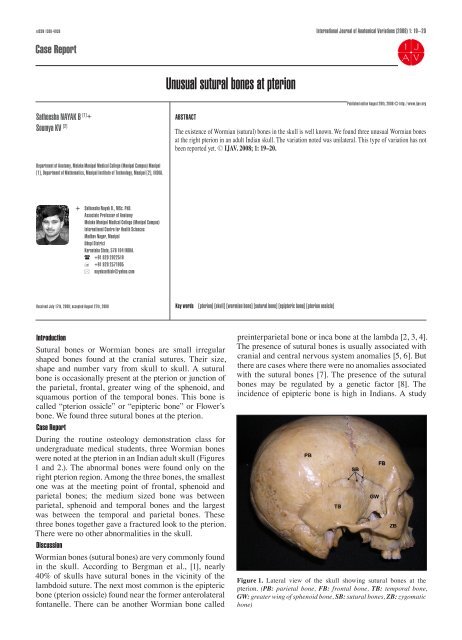Unusual sutural bones at pterion - IJAV ⢠International Journal of ...
Unusual sutural bones at pterion - IJAV ⢠International Journal of ...
Unusual sutural bones at pterion - IJAV ⢠International Journal of ...
- No tags were found...
You also want an ePaper? Increase the reach of your titles
YUMPU automatically turns print PDFs into web optimized ePapers that Google loves.
eISSN 1308-4038Case ReportIntern<strong>at</strong>ional <strong>Journal</strong> <strong>of</strong> An<strong>at</strong>omical Vari<strong>at</strong>ions (2008) 1: 19–20<strong>Unusual</strong> <strong>sutural</strong> <strong>bones</strong> <strong>at</strong> <strong>pterion</strong>Published online August 29th, 2008 © http://www.ijav.orgS<strong>at</strong>heesha NAYAK B [1]Soumya KV [2]ABSTRACTThe existence <strong>of</strong> Wormian (<strong>sutural</strong>) <strong>bones</strong> in the skull is well known. We found three unusual Wormian <strong>bones</strong><strong>at</strong> the right <strong>pterion</strong> in an adult Indian skull. The vari<strong>at</strong>ion noted was unil<strong>at</strong>eral. This type <strong>of</strong> vari<strong>at</strong>ion has notbeen reported yet. © <strong>IJAV</strong>. 2008; 1: 19–20.Department <strong>of</strong> An<strong>at</strong>omy, Melaka Manipal Medical College (Manipal Campus) Manipal[1], Department <strong>of</strong> M<strong>at</strong>hem<strong>at</strong>ics, Manipal Institute <strong>of</strong> Technology, Manipal [2], INDIA.S<strong>at</strong>heesha Nayak B., MSc. PhD.Associ<strong>at</strong>e Pr<strong>of</strong>essor <strong>of</strong> An<strong>at</strong>omyMelaka Manipal Medical College (Manipal Campus)Intern<strong>at</strong>ional Centre for Health SciencesMadhav Nagar, ManipalUdupi DistrictKarn<strong>at</strong>aka St<strong>at</strong>e, 576 104 INDIA.+91 820 2922519+91 820 2571905nayaks<strong>at</strong>hish@yahoo.comReceived July 17th, 2008; accepted August 27th, 2008Key words[<strong>pterion</strong>] [skull] [wormian bone] [<strong>sutural</strong> bone] [epipteric bone] [<strong>pterion</strong> ossicle]IntroductionSutural <strong>bones</strong> or Wormian <strong>bones</strong> are small irregularshaped <strong>bones</strong> found <strong>at</strong> the cranial sutures. Their size,shape and number vary from skull to skull. A <strong>sutural</strong>bone is occasionally present <strong>at</strong> the <strong>pterion</strong> or junction <strong>of</strong>the parietal, frontal, gre<strong>at</strong>er wing <strong>of</strong> the sphenoid, andsquamous portion <strong>of</strong> the temporal <strong>bones</strong>. This bone iscalled “<strong>pterion</strong> ossicle” or “epipteric bone” or Flower’sbone. We found three <strong>sutural</strong> <strong>bones</strong> <strong>at</strong> the <strong>pterion</strong>.Case ReportDuring the routine osteology demonstr<strong>at</strong>ion class forundergradu<strong>at</strong>e medical students, three Wormian <strong>bones</strong>were noted <strong>at</strong> the <strong>pterion</strong> in an Indian adult skull (Figures1 and 2.). The abnormal <strong>bones</strong> were found only on theright <strong>pterion</strong> region. Among the three <strong>bones</strong>, the smallestone was <strong>at</strong> the meeting point <strong>of</strong> frontal, sphenoid andparietal <strong>bones</strong>; the medium sized bone was betweenparietal, sphenoid and temporal <strong>bones</strong> and the largestwas between the temporal and parietal <strong>bones</strong>. Thesethree <strong>bones</strong> together gave a fractured look to the <strong>pterion</strong>.There were no other abnormalities in the skull.DiscussionWormian <strong>bones</strong> (<strong>sutural</strong> <strong>bones</strong>) are very commonly foundin the skull. According to Bergman et al., [1], nearly40% <strong>of</strong> skulls have <strong>sutural</strong> <strong>bones</strong> in the vicinity <strong>of</strong> thelambdoid suture. The next most common is the epiptericbone (<strong>pterion</strong> ossicle) found near the former anterol<strong>at</strong>eralfontanelle. There can be another Wormian bone calledpreinterparietal bone or inca bone <strong>at</strong> the lambda [2, 3, 4].The presence <strong>of</strong> <strong>sutural</strong> <strong>bones</strong> is usually associ<strong>at</strong>ed withcranial and central nervous system anomalies [5, 6]. Butthere are cases where there were no anomalies associ<strong>at</strong>edwith the <strong>sutural</strong> <strong>bones</strong> [7]. The presence <strong>of</strong> the <strong>sutural</strong><strong>bones</strong> may be regul<strong>at</strong>ed by a genetic factor [8]. Theincidence <strong>of</strong> epipteric bone is high in Indians. A studyFigure 1. L<strong>at</strong>eral view <strong>of</strong> the skull showing <strong>sutural</strong> <strong>bones</strong> <strong>at</strong> the<strong>pterion</strong>. (PB: parietal bone, FB: frontal bone, TB: temporal bone,GW: gre<strong>at</strong>er wing <strong>of</strong> sphenoid bone, SB: <strong>sutural</strong> <strong>bones</strong>, ZB: zygom<strong>at</strong>icbone)
20 Nayak et al.by Saxena et al., showed th<strong>at</strong> 11.79% <strong>of</strong> Indian skulls hadepipteric bone [9]. There are no reported cases <strong>of</strong> threeepipteric <strong>bones</strong> in one skull. The presence <strong>of</strong> epipteric<strong>bones</strong> may lead to complic<strong>at</strong>ions in making burr holes<strong>at</strong> the <strong>pterion</strong> [10]. Knowledge <strong>of</strong> presence <strong>of</strong> more thanone <strong>sutural</strong> bone <strong>at</strong> <strong>pterion</strong> is radiological importance.The <strong>sutural</strong> <strong>bones</strong> may be mistaken for fracture <strong>of</strong> skullin case <strong>of</strong> trauma <strong>of</strong> the <strong>pterion</strong> region. This reportmay be useful for the neurosurgeons, radiologists andanthropologists.Figure 2. Closer view <strong>of</strong> the <strong>pterion</strong> with the <strong>sutural</strong> <strong>bones</strong>. (PB:parietal bone, FB: frontal bone, TB: temporal bone, GW: gre<strong>at</strong>erwing <strong>of</strong> sphenoid bone, SB: <strong>sutural</strong> <strong>bones</strong>)References[1] Bergman RA, Afifi AK, Miyauchi R. Skeletal systems: Cranium. In: Compendium <strong>of</strong> human an<strong>at</strong>omicalvari<strong>at</strong>ions. Baltimore, Urban and Schwarzenberg. 1988; 197–205.[2] Malhotra VK, Tewari PS, Pandey SN, Tewari SP. Interparietal bone. Acta An<strong>at</strong>. (Basel). 1978; 101:94–96.[3] Saxena SK, Chowdhary DS, Jain SP. Interparietal <strong>bones</strong> in Nigerian skulls. J. An<strong>at</strong>. 1986; 144:235–237.[4] Pal GP. Vari<strong>at</strong>ions <strong>of</strong> the interparietal bone in man. J. An<strong>at</strong>. 1987; 152: 205–208.[5] Pryles CV, Khan AJ. Wormian <strong>bones</strong>. A marker <strong>of</strong> CNS abnormality? Am. J. Dis. Child. 1979; 133:380–382.[6] Das S, Suri R, Kapur V. An<strong>at</strong>omical observ<strong>at</strong>ions on os inca and associ<strong>at</strong>ed cranial deformities. FoliaMorphol. (Warsz). 2005; 64: 118–121.[7] Jeanty P, Silva SR, Turner C. Pren<strong>at</strong>al diagnosis <strong>of</strong> wormian <strong>bones</strong>. J. Ultrasound Med. 2000; 19:863–869.[8] El-Najjar M, Dawson GL. The effect <strong>of</strong> artificial cranial deform<strong>at</strong>ion on the incidence <strong>of</strong> Wormian <strong>bones</strong>in the lambdoidal suture. Am. J. Phys. Anthropol. 1977; 46: 155–160.[9] Saxena SK, Jain SP, Chowdhary DS. A compar<strong>at</strong>ive study <strong>of</strong> <strong>pterion</strong> form<strong>at</strong>ion and its vari<strong>at</strong>ions in theskulls <strong>of</strong> Nigerians and Indians. Anthropol. Anz. 1988; 46: 75–82.[10] Ersoy M, Evliyaoglu C, Bozkurt MC, Konuskan B, Tekdemir I, Keskil IS. Epipteric <strong>bones</strong> in the <strong>pterion</strong>may be a surgical pitfall. Minim. Invasive Neurosurg. 2003; 46: 363–365.













